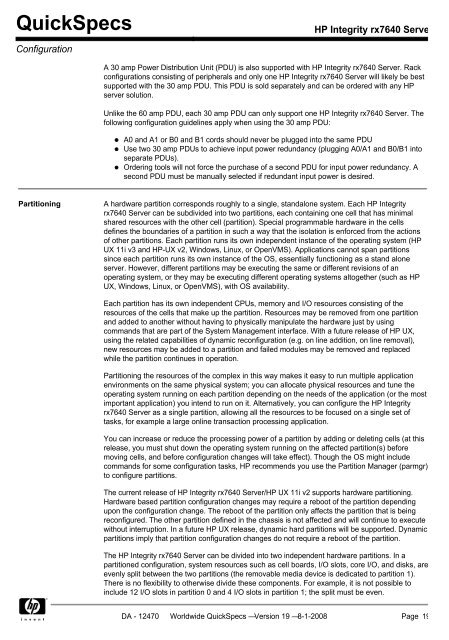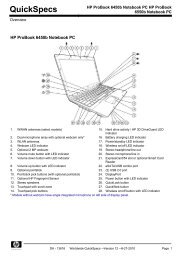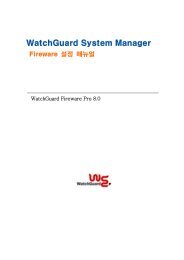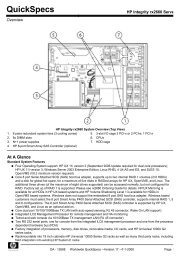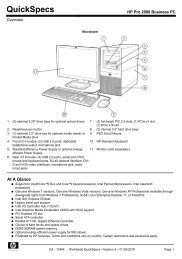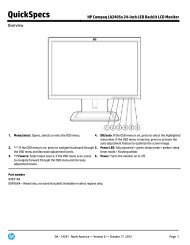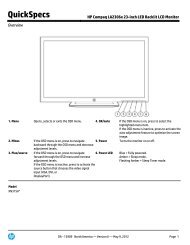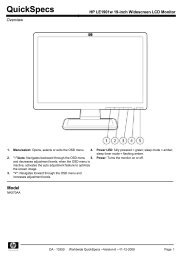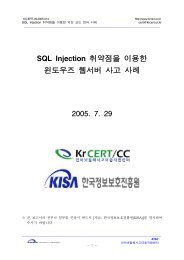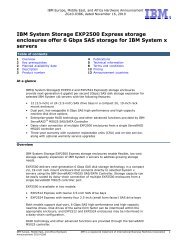HP Integrity rx7640 Server
HP Integrity rx7640 Server
HP Integrity rx7640 Server
Create successful ePaper yourself
Turn your PDF publications into a flip-book with our unique Google optimized e-Paper software.
QuickSpecs<strong>HP</strong> <strong>Integrity</strong> <strong>rx7640</strong> <strong>Server</strong>ConfigurationA 30 amp Power Distribution Unit (PDU) is also supported with <strong>HP</strong> <strong>Integrity</strong> <strong>rx7640</strong> <strong>Server</strong>. Rackconfigurations consisting of peripherals and only one <strong>HP</strong> <strong>Integrity</strong> <strong>rx7640</strong> <strong>Server</strong> will likely be bestsupported with the 30 amp PDU. This PDU is sold separately and can be ordered with any <strong>HP</strong>server solution.Unlike the 60 amp PDU, each 30 amp PDU can only support one <strong>HP</strong> <strong>Integrity</strong> <strong>rx7640</strong> <strong>Server</strong>. Thefollowing configuration guidelines apply when using the 30 amp PDU:A0 and A1 or B0 and B1 cords should never be plugged into the same PDUUse two 30 amp PDUs to achieve input power redundancy (plugging A0/A1 and B0/B1 intoseparate PDUs).Ordering tools will not force the purchase of a second PDU for input power redundancy. Asecond PDU must be manually selected if redundant input power is desired.PartitioningA hardware partition corresponds roughly to a single, standalone system. Each <strong>HP</strong> <strong>Integrity</strong><strong>rx7640</strong> <strong>Server</strong> can be subdivided into two partitions, each containing one cell that has minimalshared resources with the other cell (partition). Special programmable hardware in the cellsdefines the boundaries of a partition in such a way that the isolation is enforced from the actionsof other partitions. Each partition runs its own independent instance of the operating system (<strong>HP</strong>UX 11i v3 and <strong>HP</strong>-UX v2, Windows, Linux, or OpenVMS). Applications cannot span partitionssince each partition runs its own instance of the OS, essentially functioning as a stand aloneserver. However, different partitions may be executing the same or different revisions of anoperating system, or they may be executing different operating systems altogether (such as <strong>HP</strong>UX, Windows, Linux, or OpenVMS), with OS availability.Each partition has its own independent CPUs, memory and I/O resources consisting of theresources of the cells that make up the partition. Resources may be removed from one partitionand added to another without having to physically manipulate the hardware just by usingcommands that are part of the System Management interface. With a future release of <strong>HP</strong> UX,using the related capabilities of dynamic reconfiguration (e.g. on line addition, on line removal),new resources may be added to a partition and failed modules may be removed and replacedwhile the partition continues in operation.Partitioning the resources of the complex in this way makes it easy to run multiple applicationenvironments on the same physical system; you can allocate physical resources and tune theoperating system running on each partition depending on the needs of the application (or the mostimportant application) you intend to run on it. Alternatively, you can configure the <strong>HP</strong> <strong>Integrity</strong><strong>rx7640</strong> <strong>Server</strong> as a single partition, allowing all the resources to be focused on a single set oftasks, for example a large online transaction processing application.You can increase or reduce the processing power of a partition by adding or deleting cells (at thisrelease, you must shut down the operating system running on the affected partition(s) beforemoving cells, and before configuration changes will take effect). Though the OS might includecommands for some configuration tasks, <strong>HP</strong> recommends you use the Partition Manager (parmgr)to configure partitions.The current release of <strong>HP</strong> <strong>Integrity</strong> <strong>rx7640</strong> <strong>Server</strong>/<strong>HP</strong> UX 11i v2 supports hardware partitioning.Hardware based partition configuration changes may require a reboot of the partition dependingupon the configuration change. The reboot of the partition only affects the partition that is beingreconfigured. The other partition defined in the chassis is not affected and will continue to executewithout interruption. In a future <strong>HP</strong> UX release, dynamic hard partitions will be supported. Dynamicpartitions imply that partition configuration changes do not require a reboot of the partition.The <strong>HP</strong> <strong>Integrity</strong> <strong>rx7640</strong> <strong>Server</strong> can be divided into two independent hardware partitions. In apartitioned configuration, system resources such as cell boards, I/O slots, core I/O, and disks, areevenly split between the two partitions (the removable media device is dedicated to partition 1).There is no flexibility to otherwise divide these components. For example, it is not possible toinclude 12 I/O slots in partition 0 and 4 I/O slots in partition 1; the split must be even.DA - 12470 Worldwide QuickSpecs — Version 19 — 8-1-2008 Page 19


